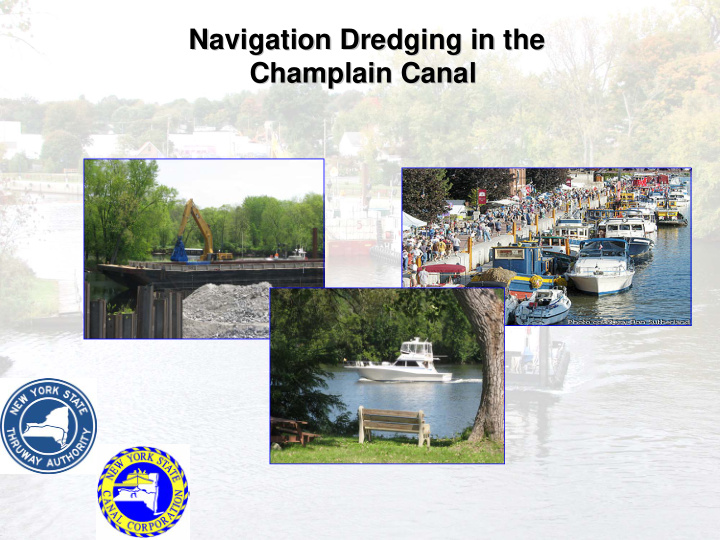



Navigation Dredging in the Navigation Dredging in the Champlain Canal Champlain Canal
Canal System Overview • The Canal System is comprised of four waterways: • The Erie Canal – 338 miles long • The Champlain Canal – 60 miles long • The Oswego Canal – 24 miles long • The Cayuga & Seneca Canal – 12 miles long • The System includes approximately 1,800 structures including 57 locks, 20 moveable bridges, dams, and walls.
What is the Navigation Channel? • An area of the waterway that is maintained to allow the safe passage of vessels. • Champlain Canal has design depth of 12 feet within the navigation channel boundaries. • Channel width in the river section is 200 feet. • Champlain Canal is “canalized river” from Fort Edward to Waterford.
History of the Champlain Canal • Modern Champlain Canal was fully opened to traffic in 1916. • By 1920s, the need for routine maintenance dredging became apparent. • NYS built or commissioned a number of dredges and support vessels to conduct regular maintenance.
History of the Champlain Canal • 1973: Removal of the Fort Edward Dam • 1974-79: Multiple rounds of emergency dredging necessary to restore navigation • 1980-Present: No maintenance dredging (with the exception of Hoosic River)
History of the Champlain Canal
History of the Champlain Canal • Since the early 1980s, New York State DOT and Canal Corporation have not been able to maintain the navigation channel in the Hudson River/Champlain Canal due to the presence of sediments contaminated with PCBs. • Navigability of the Hudson River/Champlain Canal has gradually declined over the years. Large vessels now routinely have difficulty navigating some sections of the canalized river.
Navigational Impacts of PCB Contamination • Available depths and channel widths are reduced (see NYSCC maps) • Reduced depths and widths particularly impact the size of tug boats and barges that can safely navigate the river • Commercial traffic must use smaller, lighter loads which has a direct impact on the cost-effectiveness of water transport • Even some large recreational vessels are impacted
Navigational Dredging vs. Remedial Dredging • EPA Remedy is based on “hot spot” removal • “3/10/Select” hot spot standard • All “hot spots” will be dredged to achieve goal of 1 ppm Tri+ PCB residuals • Majority of the river below Lock C6 will remain unremediated.
Navigational Dredging vs. Remedial Dredging • Out of 2.4 million cubic yards in GE’s dredging program, only 92,000 cubic yards will improve navigation. • The remedial dredging program will remove less than 15% of the total navigation dredging needs in the river. • More than 628,000 cy of contaminated sediment will remain in the navigation channel
Navigational Dredging vs. Remedial Dredging BEFORE: AFTER: 13,103 cy GE/EPA Removes Navigation 2,010 cy Dredging Needed 11,093 cy Remaining
Requirements for Navigational Dredging • Navigational Dredging is governed by state and federal requirements: – Army Corps Section 404 Permit – DEC Section 401 Water Quality Certification – DEC Part 360 Solid Waste Regulations – EPA TSCA Requirements – DEC Part 370 Hazardous Waste Regulations
Navigational Dredging vs. Remedial Dredging • EPA Remedial Residual Standard = 1ppm Tri+ PCBs (Approximately equal to 2-3 ppm Total PCBs) • DEC Standard for PCBs is 1 ppm Total PCBs – Greater than this and special handling and disposal requirements apply (case-by-case)
Requirements for Navigational Dredging • Complications from PCBs: – Cannot use existing NYSCC equipment – Cannot use traditional Upland Disposal Sites – New dewatering facility would require Solid Waste Facility Permit – High PCB concentrations may require Hazardous Waste Facility Permit • Siting requirements
Solutions • Current remedial project is exempt from obtaining permits (substantive requirements must be met). • It is administratively and economically more feasible to conduct navigational dredging during Phase 2. • 32 Champlain Canal municipalities have passed resolutions advocating that navigational dredging be conducted during Phase 2.
Contact Information Contact Information Joseph Moloughney, P.E., Director of Environmental Affairs New York State Canal Corporation P.O. Box 189, Albany 12201 (518) 436 - 3055 www.nyscanals.gov
Recommend
More recommend